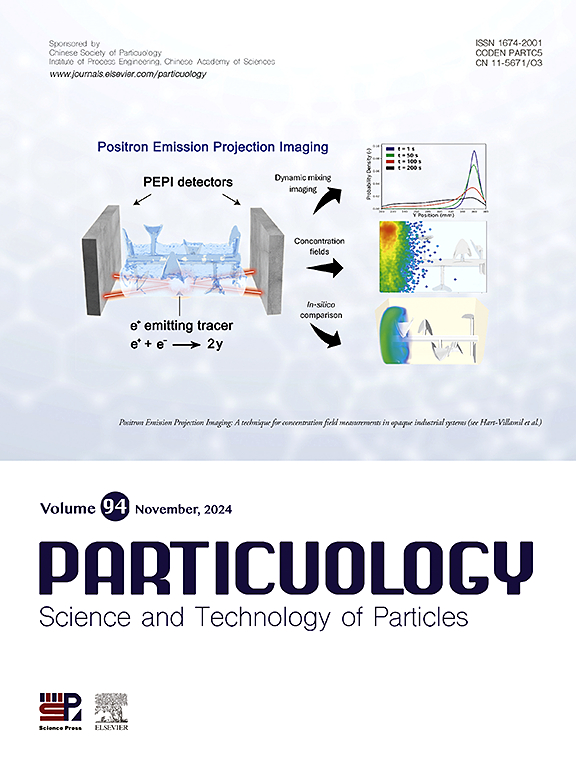A mechanical-thermal-chemical coupling discrete element method model for simulating hotspot generation and ignition in HMX-based explosives
IF 4.3
2区 材料科学
Q2 ENGINEERING, CHEMICAL
引用次数: 0
Abstract
Polymer-bonded explosives (PBXs) are widely used in military applications due to their high energy density, but their safety under impact loading remains a critical concern due to hotspot-induced ignition risks. While existing experimental and continuum methods face limitations in capturing sub-millisecond mesoscale processes and discontinuous damage evolution, this study develops an integrated Discrete Element Method (DEM) framework integrating the Edinburgh Elasto-Plastic-Adhesive (EEPA) contact model with Arrhenius reaction kinetics, where mechanical energy dissipation deterministically drives thermal-chemical ignition. The framework successfully predicts hotspot generation and ignition thresholds in cyclotetramethylene tetranitramine (HMX) particle explosives under impact loading. The maximum temperatures of the cubic sample are consistent with the literature and the verification analysis of a Steven Test is aligned with an experiment in literature. Application to Spigot and Drop Tests reveals strain energy accumulation and damping dissipation as dominant ignition mechanisms, with chemical activation showing exponential dependence on mechanical heating. Compared to existing DEM studies focusing on single-physics processes, this work establishes a more comprehensive and better predictive tool for mapping mechanical loading conditions to ignition thresholds.

基于机械-热-化学耦合的hmx炸药热区生成与点火模拟离散元方法模型
聚合物粘结炸药(PBXs)由于其高能量密度而广泛应用于军事领域,但其在冲击载荷下的安全性仍然是一个关键问题,因为它存在热点引燃风险。虽然现有的实验和连续方法在捕获亚毫秒中尺度过程和不连续损伤演化方面存在局限性,但本研究开发了一种集成的离散元方法(DEM)框架,将爱丁堡弹塑性胶粘剂(EEPA)接触模型与Arrhenius反应动力学相结合,其中机械能耗散确定性地驱动热化学点火。该框架成功地预测了冲击载荷下环四亚甲基四胺(HMX)颗粒炸药的热点生成和点火阈值。立方试样的最高温度与文献一致,Steven Test的验证分析与文献中的实验一致。对龙头和跌落试验的应用表明,应变能积累和阻尼耗散是主要的点火机制,化学激活对机械加热表现出指数依赖。与现有的专注于单一物理过程的DEM研究相比,这项工作建立了一个更全面、更好的预测工具,用于绘制机械加载条件和点火阈值。
本文章由计算机程序翻译,如有差异,请以英文原文为准。
求助全文
约1分钟内获得全文
求助全文
来源期刊

Particuology
工程技术-材料科学:综合
CiteScore
6.70
自引率
2.90%
发文量
1730
审稿时长
32 days
期刊介绍:
The word ‘particuology’ was coined to parallel the discipline for the science and technology of particles.
Particuology is an interdisciplinary journal that publishes frontier research articles and critical reviews on the discovery, formulation and engineering of particulate materials, processes and systems. It especially welcomes contributions utilising advanced theoretical, modelling and measurement methods to enable the discovery and creation of new particulate materials, and the manufacturing of functional particulate-based products, such as sensors.
Papers are handled by Thematic Editors who oversee contributions from specific subject fields. These fields are classified into: Particle Synthesis and Modification; Particle Characterization and Measurement; Granular Systems and Bulk Solids Technology; Fluidization and Particle-Fluid Systems; Aerosols; and Applications of Particle Technology.
Key topics concerning the creation and processing of particulates include:
-Modelling and simulation of particle formation, collective behaviour of particles and systems for particle production over a broad spectrum of length scales
-Mining of experimental data for particle synthesis and surface properties to facilitate the creation of new materials and processes
-Particle design and preparation including controlled response and sensing functionalities in formation, delivery systems and biological systems, etc.
-Experimental and computational methods for visualization and analysis of particulate system.
These topics are broadly relevant to the production of materials, pharmaceuticals and food, and to the conversion of energy resources to fuels and protection of the environment.
 求助内容:
求助内容: 应助结果提醒方式:
应助结果提醒方式:


